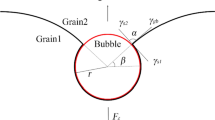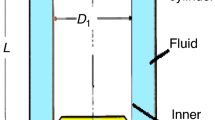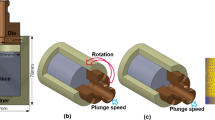Abstract
Velocity and volume measurements of gas bubbles injected into liquid metals under laminar flow conditions (at the orifice) have been achieved. A novel experimental approach utilizing noises generated by bubbles was used to collect the necessary data. Argon gas was bubbled through tin, lead, and copper melts, and gas bubble formation frequencies (and hence bubble sizes) were determined. It was found that the bubble size generated for a particular orifice diameter was dependent upon the magnitudes of the orifice Froude and Weber numbers. Maximum formation frequencies increased slightly with decreasing orifice diameter, and the transition point from varying to constant frequency occurred at an orifice Weber number of approximately 0.44. Velocities of gas bubbles rising through the metals were greater than those previously reported for studies in which only one bubble was in the melt at any time. Effective drag coefficients of the rising bubbles were found to agree with data previously generated in aqueous systems.
Similar content being viewed by others
Abbreviations
- C D :
-
effective drag coefficient, 4gdb[3u2 b]−1
- d b :
-
gas bubble diameter, cm,
- d o :
-
orifice diameter, cm,
- F :
-
bubble formation frequency, s−1,
- g :
-
gravitational constant, cm s−2,
- ’h :
-
adjusted melt depth, cm,
- N Reo :
-
orifice Reynolds number,d ovo[vg]1,
- N Fro :
-
orifice Froude number, v2 o[gdo −1,
- N weo :
-
orifice Weber number, dov2 opg[σ]−1,
- N Reb :
-
bubble Reynolds number, dbub[vL]−1,
- N Frb :
-
bubble Froude number, pgv2 b [(pl-Pg)gdb]−1,
- N web :
-
bubble Weber number, dbu2bpL[σ]−1
- N mo :
-
liquid phase Morton number, gμ4L[pLσ3]−1,
- Qt :
-
gas flowrate at temperature, cm3 s−1
- S b :
-
center to center spacing of bubbles in melt, cm
- t r :
-
residence time of gas bubble in melt, s
- u b :
-
gas bubble velocity in melt, cm s−1
- v o :
-
gas velocity at orifice, cm s−1
- V g :
-
kinematic viscosity of gas, cm2 s−1
- vL :
-
kinematic viscosity of liquid, cm2 s−1
- σ :
-
surface tension, dyne cm−1
References
D. W. van Krevelen and P. J. Hoftijzei:Chem. Eng. Prog., 1950, vol. 46, p. 29.
I. Leibson,et al:Advanc. Chem. Eng., 1956, vol. 2, p. 296.
L. Davidson and E. H. Amick:Advanc. Chem. Eng., 1956, vol. 2, p. 337.
R.R. Hughes,et al:Chem. Eng. Prog, 1955, vol. 51, p. 557.
W. B. Hayes,et al:Advanc. Chem. Eng., 1959, vol. 5, p. 319.
S.L. Sullivan,et al:Advanc. Chem. Eng., 1964, vol. 10, p. 848.
W. Siemes:Chem. Eng. Tech., 1954, vol. 26, p. 479.
W. Siemes and J. F. Kaufmann:Chem. Eng. Sci., 1956, vol. 5, p. 127.
W. Siemes and K. Günther:Chem. Eng. Tech., 1956, vol. 28, p. 389.
J. F. Davidson and B. 0. G. Schüler:Trans. Inst. Chem. Eng., 1960, vol. 38, p. 144.
J. F. Davidson and B. 0. G. Schüler:Trans. Inst. Chem. Eng., 1960, vol. 38, p. 335.
R. Kumar,et al:Chem. Eng. Sel, 1969, vol. 24, p. 749.
R. D. Lanauze and I. J. Harris:Chem. Eng. Sci., 1974, vol. 29, p. 1663.
R. D. Lanauze and I. J. Harrison:Chem. Eng. Sci., 1972, vol. 27, p. 2102.
M. Sano and K. Mori:Tetsu-to-Hagane, 1974, vol. 60, p. 348.
J. Szekely and N. J. Themelis:Rate Phenomena in Process Metallurgy, pp. 368, 688–92, John Wiley and Sons, New York, 1971.
W. L. Haberman and R.K.Morton:David Taylor Model Basin Rep., U.S. Dept. of Naval Research, No. 802,1953.
F. N. Peebles and H. J. Garber:Chem. Eng. Prog., 1953, vol. 39, p. 88.
R. A. Hartunian and W. R. Sears:J. FluidMech., 1957, vol. 3, p. 27.
F. H. Garner and D. Hammerton:Chem. Eng. Sci, 1954, vol. 3, p. 1.
R. M. Davies and G. I. Taylor:Proc. Roy. Soc, London, 1950, vol. 200, Ser. A, p. 375.
S. Uno and R. C. Kintner:Advanc. Chem. Eng., 1956, vol. 2, p. 420.
W. G. Davenport,et al:J. Iron SteelInst., 1967, vol. 205, p. 1034.
M. Paneni and W. G. Davenport:Trans. TMS-AIME, 1969, vol. 245, p. 735.
E. N. Sieder and G. E. Täte:Ind. Eng. Chem., 1936, vol. 28, p. 1429.
J.H. Perry:Chemical Engineers Handbook, 4th ed., pp. 10–10 to 10–13, McGraw Hill Book Co., New York, 1963.
D. H. Napier:GasAbsorp. Working Party Rep. No. 10, Imperial College, London, March, 1949.
Author information
Authors and Affiliations
Additional information
R. J. ANDREINI, Formerly Graduate Student, Michigan Technological University,
Rights and permissions
About this article
Cite this article
Andreini, R.J., Foster, J.S. & Callen, R.W. Characterization of gas bubbles injected into molten metals under laminar flow conditions. Metall Trans B 8, 625–631 (1977). https://doi.org/10.1007/BF02669340
Received:
Issue Date:
DOI: https://doi.org/10.1007/BF02669340




